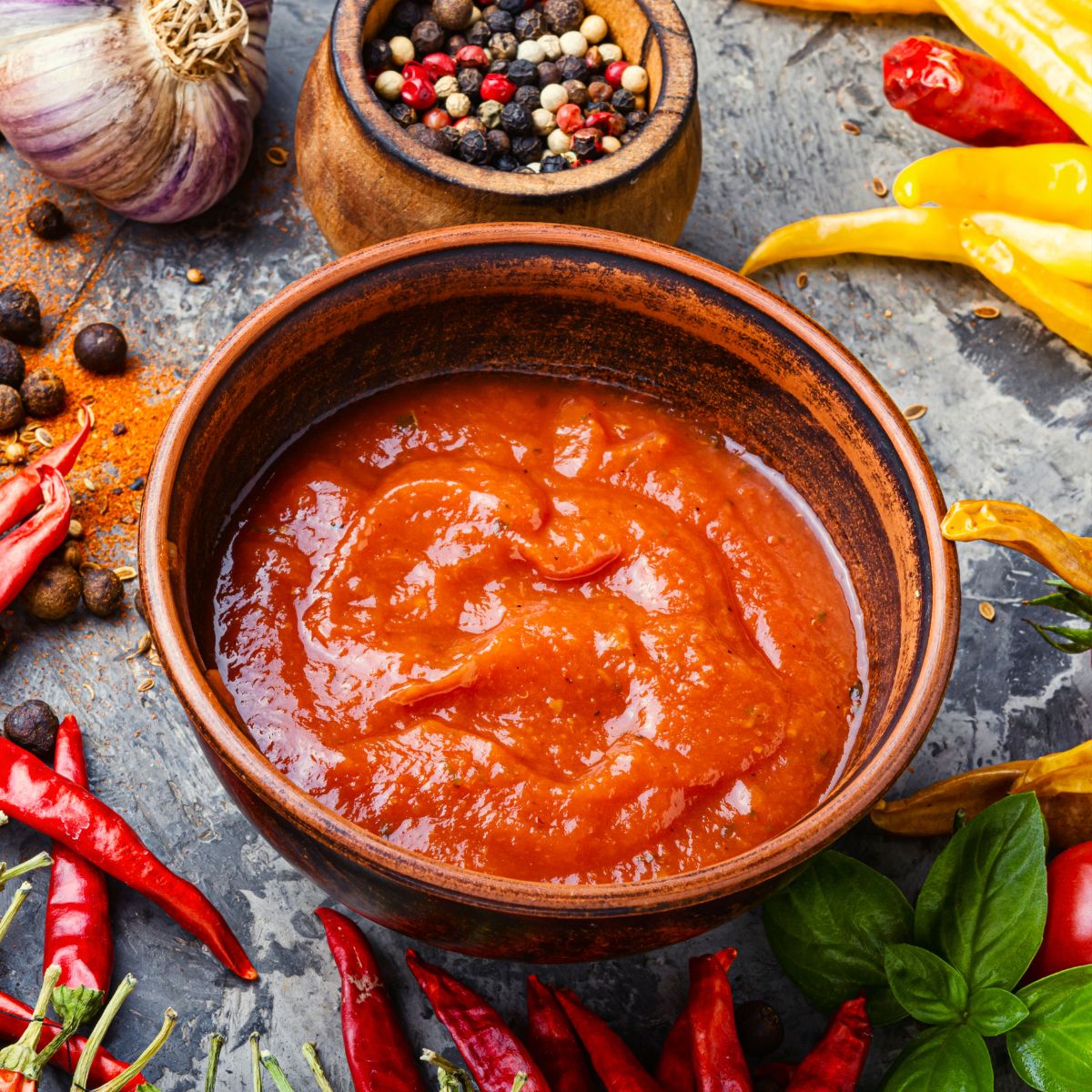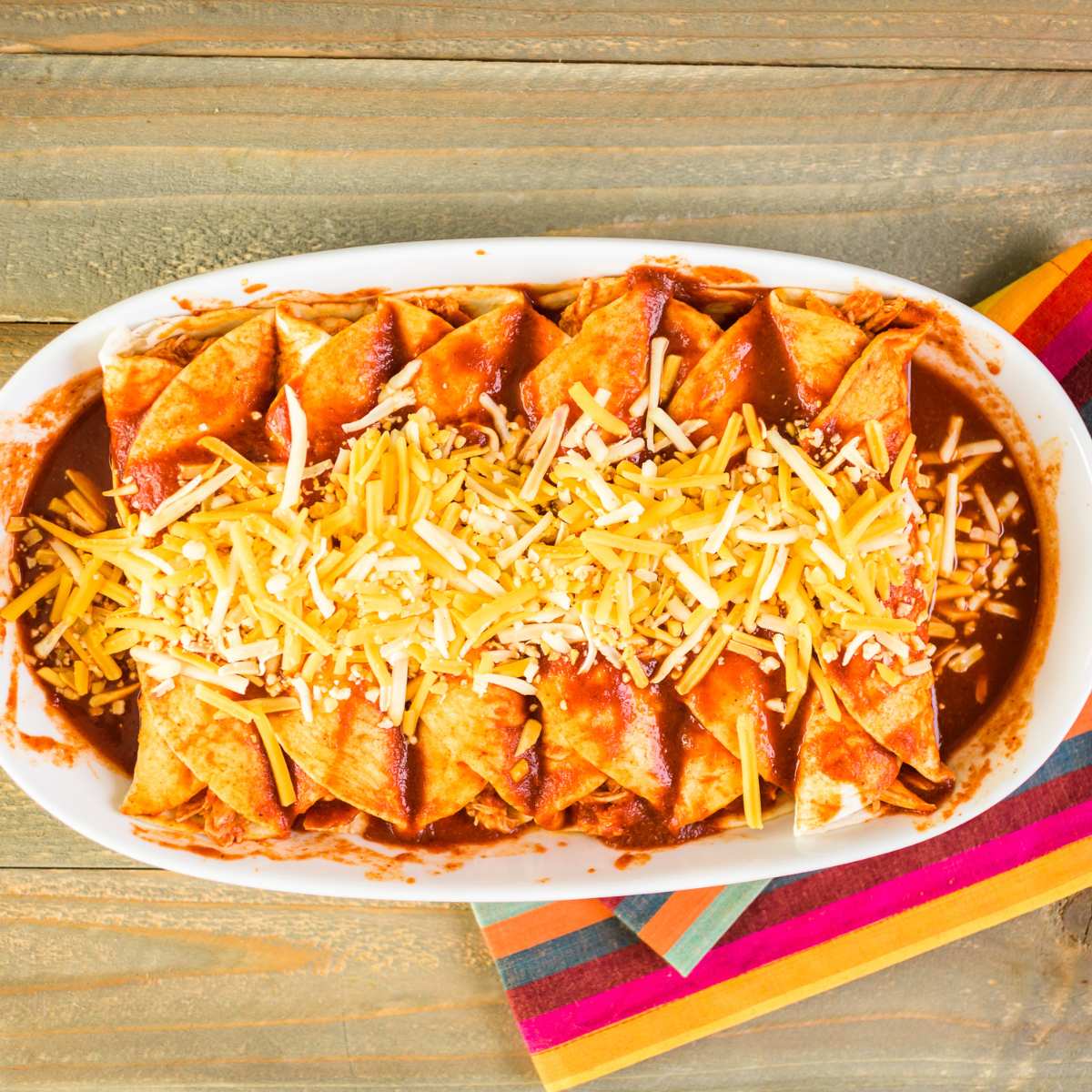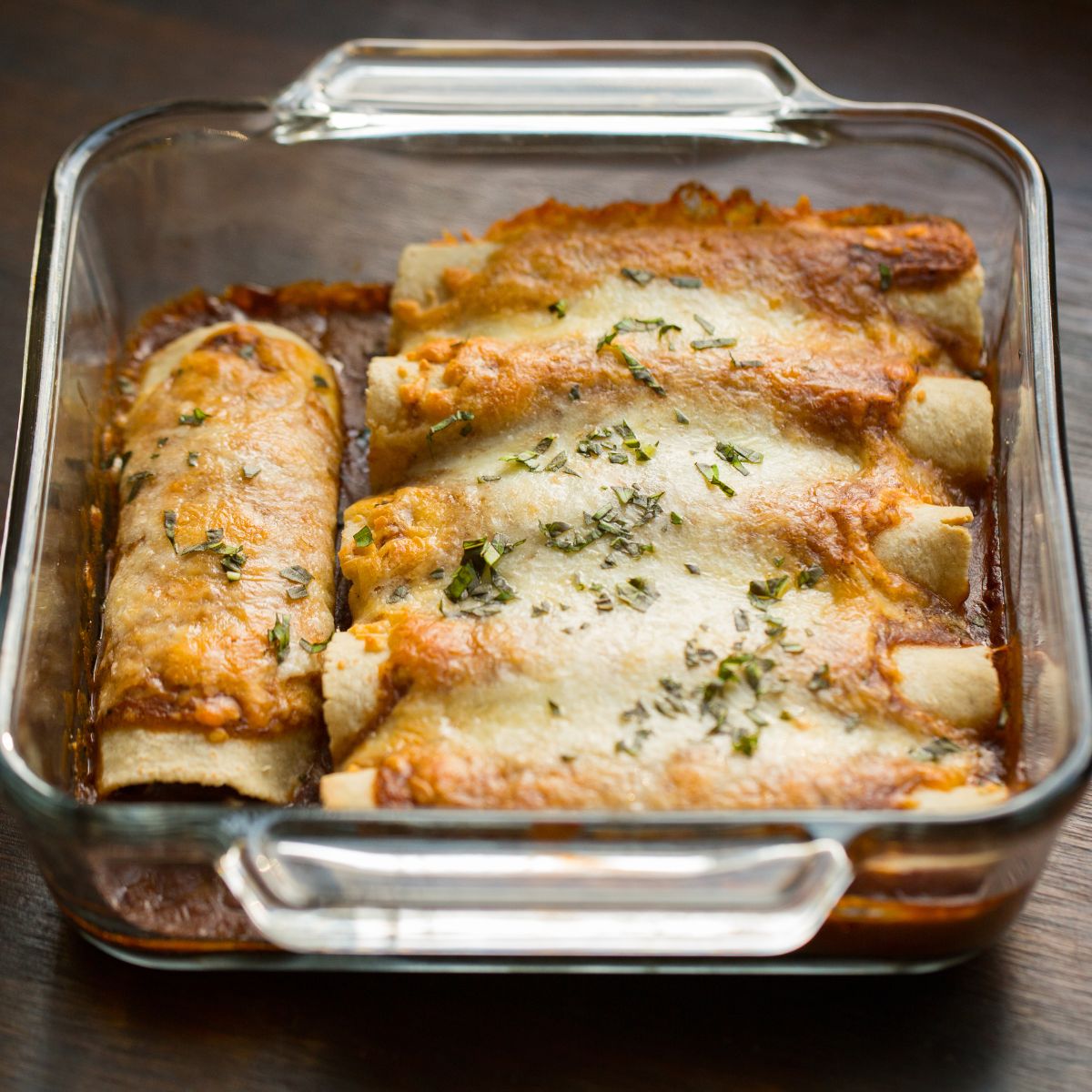If you’ve ever wondered, “What is an enchilada?” you’re in for a flavorful journey. This beloved dish is a staple of Mexican cuisine, featuring corn tortillas rolled around a filling and covered with a chili pepper sauce.
Enchiladas are celebrated for their versatility and rich history, evolving from ancient traditions to modern dinner tables across the globe. Keep reading to discover the various types of enchiladas, how they’re made, and why they remain a favorite among food lovers everywhere.
The History of Enchiladas: A Journey Through Mexican Culinary Tradition
When you bite into an enchilada, you’re not just tasting a dish, you’re indulging in centuries of history and culinary tradition. Originating from the time of the ancient Mayans, enchiladas began as simple corn tortillas rolled around small fish or other meats.
This basic recipe set the foundation for what would evolve into a rich and diverse array of fillings and sauces, reflecting the local taste and ingredients of different regions in Mexico.
The word “enchilada” itself comes from the Spanish verb enchilar, which means “to season with chili.” This name points to the dish’s essence: the liberal use of chili peppers, which are integral to its flavor. Over the centuries, enchiladas have grown from a humble peasant food to a complex dish that embodies the spirit of Mexican gastronomy.
Today, enchiladas are celebrated as a quintessential Mexican dish, cherished not only for their delicious taste but also for their cultural significance. They are a culinary symbol that connects generations, embodying the tradition of transformation and adaptation in Mexican cooking.
From their roots in ancient agriculture to their ubiquitous presence in modern Mexican cuisine and beyond, enchiladas continue to be a vibrant part of the cultural and culinary landscape.
What is an Enchilada: What Makes It Unique?
An enchilada is much more than just another item on a Mexican menu; it’s a showcase of the harmony between simple ingredients and rich flavors that characterize Mexican cuisine.
The Trio of Simplicity: Tortillas, Filling, and Sauce
The foundation of any true enchilada is the tortilla. Traditionally made from corn, these tortillas serve as the sturdy yet tender wrap that holds everything together. For a twist, some versions use flour tortillas, offering a different texture and flavor profile.
The soul of the enchilada is its filling and sauce. Fillings vary widely, including options like shredded chicken, ground beef, cheese, or combinations of vegetables, each bringing its own set of flavors.
However, the real magic lies in the sauce. Red and green chili sauces, rich in spices and Mexican herbs, are not just toppings but integral to the dish, soaking the rolled tortillas with intense flavor. This method of preparing the tortillas—lightly frying, then dipping in the sauce before being filled and rolled—is what sets enchiladas apart from other tortilla-based dishes.
The Art of Rolling the Perfect Enchilada
Making enchiladas is an art, starting from warming the tortillas to prevent breaking when rolled. The filling is added carefully—not too much, as this isn’t a burrito. Each tortilla is then rolled gently and finished with more sauce and a sprinkle of cheese, baked until bubbly and delicious. This preparation makes every enchilada a celebration of texture and taste, a culinary tradition that’s both hearty and delightfully complex.
Decoding the Enchilada Sauce: Tomato vs. Tomatillo
When it comes to enchiladas, the sauce is not just a component—it’s the heart of the dish. The great debate between tomato-based and tomatillo sauces is more than just a matter of taste; it’s about understanding the unique taste each brings to your enchilada.
- Tomato-Based Sauce: This sauce is renowned for its rich, deep flavor, combining the sweetness of tomatoes with a robust blend of chili peppers and spices. It coats the enchiladas with a comforting, warm hug of flavor that is both familiar and immensely satisfying.
- Tomatillo Sauce: Known as salsa verde, this vibrant green sauce offers a fresher, tangier alternative. Made from the Mexican husk tomato, it introduces a lively, slightly acidic taste that can elevate the flavor profile of your enchiladas. It’s not just about the tang; it’s about adding a burst of brightness that cuts through richer fillings.
The choice between tomato and tomatillo sauce can profoundly affect the character of an enchilada dish. Tomato sauces tend to complement hearty, meat-heavy fillings by adding depth and richness, while tomatillo sauces work beautifully with lighter ingredients like chicken and cheese, providing a zesty contrast.
Diving into the Rich Variety of Enchiladas
Whether you’re a fan of creamy sauces or fresh seafood, there’s an enchilada variation waiting to be savored. Let’s explore some popular types:
Enchiladas Rojas
For those who love a touch of heat, Enchiladas Rojas are the perfect choice. Covered in a robust red chili sauce that packs both flavor and spice, these enchiladas promise to dance on your palate with every bite, bringing a vibrant zest to your meal.
Enchiladas Verdes
Enchiladas Verdes are known for their tangy and mildly spicy green tomatillo sauce. Often filled with chicken, these enchiladas are refreshing and lighter compared to their red-sauced counterparts.
Enchiladas Suizas
Known for their creamy, cheesy goodness, Enchiladas Suizas are a delightful twist on the traditional enchilada. Topped with a rich, velvety white cream sauce and plenty of melted cheese, they offer a comforting experience akin to a warm embrace from your favorite abuela.
Enchiladas de Mole
Featuring the complex and rich flavors of mole sauce, which includes ingredients like chocolate, spices, and chili peppers, Enchiladas de Mole is a gourmet treat that blends sweet, spicy, and savory notes in one dish.
Seafood Enchiladas
Dive into the refreshing flavors of the ocean with Seafood Enchiladas. Filled with tender pieces of shrimp, crab, or fish, and sometimes enhanced with a creamy sauce, these enchiladas are a seafood lover’s dream, offering a lighter alternative to the more traditional meat-filled varieties.
Vegetarian Enchiladas
Celebrate the bounty of the garden with Vegetarian Enchiladas. Packed with a colorful mix of vegetables or innovative ingredients like jackfruit, these enchiladas are drizzled with either a spicy red or a tangy green sauce, making them a hearty and satisfying option for vegetarians and meat-eaters alike.
How to Make Enchiladas: A Step-by-Step Guide
Ready to transform your kitchen into a mini Mexican fiesta with homemade enchiladas? Crafting these flavorful rolls is an art that combines traditional ingredients with a few culinary tricks. Here’s how to make enchiladas that’ll have everyone asking for seconds:
- Select Quality Ingredients: Begin with high-quality corn or flour tortillas—these are crucial for authentic enchiladas. For the fillings, choose options like tender chicken, hearty beef, or for vegetarians, a mix of bell peppers, onions, and black beans. Spice things up with cumin, chili powder, and garlic for that deep, authentic flavor.
- Prepare the Tortillas: To make your tortillas pliable and ready to roll without breaking, lightly fry them in oil for a few seconds on each side. This step is essential to prevent tearing when they are filled and rolled.
- Assemble the Enchiladas: Spread your warmed tortillas on a flat surface, spoon in your chosen fillings, and roll them up tightly. Place them seam-side down in a baking dish to keep them from unrolling.
- Smother with Sauce: Cover your rolled tortillas generously with your choice of enchilada sauce—red chili sauce for a classic taste or green tomatillo sauce for a tangy twist. This adds flavor and keeps the enchiladas moist while baking.
- Top with Cheese: Sprinkle a generous amount of cheese over your sauce-covered enchiladas. Opt for a melty cheese like cheddar or Monterey Jack for that perfect gooey texture.
- Bake to Perfection: Bake your enchiladas in a preheated oven at 375°F (190°C) until the cheese is bubbling and the edges are slightly crispy, about 20-25 minutes.
Follow these steps to ensure your enchiladas are not just delicious but also a vibrant celebration of traditional Mexican flavors. Now, heat up your oven and get ready to enjoy a delicious batch of homemade enchiladas!
Perfect Sides to Complement Enchiladas
A great meal becomes unforgettable with the right accompaniments. Here are some classic side dishes that pair wonderfully with enchiladas:
- Mexican Rice: This vibrant and flavorful rice is a staple side that adds a hearty element to any enchilada dish.
- Refried Beans: Creamy refried beans serve as a rich and satisfying complement, adding a smooth texture and protein-packed bite.
- Light Salad: Incorporate a light salad to balance the richness of enchiladas. Opt for a Mexican Caesar salad that brings a crisp freshness to your meal with its creamy dressing and crunchy croutons.
- Cilantro Lime Rice: A zesty side that brings a burst of freshness with its lime juice and cilantro, cilantro lime rice is perfect for cutting through the heaviness of cheese and sauce.
- Mexican Guacamole: Fresh guacamole made from ripe avocados, onions, tomatoes, and cilantro offers a cool and creamy contrast to the warm and spicy flavors of enchiladas.
Conclusion
To wrap up, the enchilada is more than just food; it’s a cultural artifact, rich with history and bursting with flavor. Whether smothered in red, green, or mole sauce or filled with meat, seafood, or fresh vegetables, enchiladas offer something for every palate.
We’ve explored everything from the basics of what makes an enchilada to the intricate varieties that showcase the depth of Mexican cuisine. Remember, each enchilada you enjoy carries the essence of centuries-old traditions right to your plate. So next time you savor this dish, think of the vast culinary heritage it represents, and enjoy each bite as a taste of history.
FAQ
What makes enchiladas red or green?
The color of the enchilada sauce depends on the chilies used. Red enchiladas use tomatoes and red chili peppers, while green enchiladas are made with tomatillos and green chili peppers like jalapeños or serranos.
Are enchiladas spicy?
The spiciness of enchiladas depends on the sauce used. Red and green sauces can range from mild to very spicy based on the chili peppers used. To control the heat level, adjust the type and amount of chili peppers in your sauce recipe.
Is there a preferred cheese for making enchiladas?
In Mexico, quesillo or asadero cheese is often used for its excellent melting qualities. Outside Mexico, common substitutes include Monterey Jack, cheddar, or a mix of both. Choose a cheese that melts well for the best texture.
What is the difference between enchiladas and burritos?
Enchiladas are typically made with corn tortillas and covered in chili sauce, then baked. Burritos, on the other hand, are made with larger flour tortillas, filled with a variety of ingredients, including beans, rice, and meat, and are not baked.
Can enchiladas be frozen for later use?
Yes, enchiladas freeze well. Assemble them but hold off on baking. Wrap the dish tightly with plastic wrap, then foil it, and freeze it. When ready to eat, bake straight from frozen, just extending the cooking time.
How can I make enchiladas healthier?
To make healthier enchiladas, use lean proteins like chicken or turkey, increase the amount of vegetables in the filling, use whole grain or low-carb tortillas, and choose low-fat cheese.






